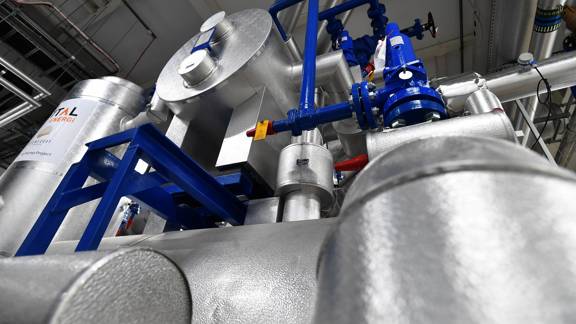How heat networks can reduce emissions for Scottish homes and businesses
05 Sep 2024 • 5 minute read
District heating is providing thousands of Scottish homes and businesses with clean heat.

When all uses across industries and buildings are combined, heat is the greatest source of carbon emissions in the UK.
To reduce Scotland’s carbon footprint, district heat networks are being established in several regional developments.
With a traditional gas-fired boiler, water is heated inside a property. For district heating, heat is generated externally and distributed to many properties in the form of steam or hot water.
Heat sources are typically located near end-users, reducing travelling distance and the potential for heat loss. This means heat networks are most effective in areas of high population density such as towns or cities.
As well as decreasing emissions, district heating can also result in a significant reduction in energy bills. Nordic countries were early adopters of heat networks and have already seen these benefits.
However, Scotland is quickly catching up. Already 1,080 heat networks are operating across Scotland, heating more than 34,000 homes. By 2030, Scotland aims to increase this to 650,000 buildings, with more than £20 billion of investment planned by 2050.
Successful 4G heating projects underway
New fourth-generation (4G) heat networks aren't just using alternative sources to fossil fuels they're making heating distribution more efficient. Queen’s Quay 4G District Heating Network near Glasgow is one flagship project demonstrating Scotland’s efforts to upgrade heat systems.
Featuring the first water-source industrial-scale heat pump in Scotland, the operational network is connected to several commercial buildings and homes. It is estimated that the project will eventually decrease the carbon footprint of the area by 60%.
Shawfair is a new town under construction south-east of Edinburgh that will be served by a heat network. Serving 3,000 homes, the network will take heat from Millerhill recycling and energy recovery centre, as well as old mines.
A few miles north at Granton Waterfront development, the City of Edinburgh plans to heat 3,500 homes a year. Using low-grade heat from a sewer, the first properties are scheduled for delivery in September 2025. The network is planned to provide 25,000-megawatt hours of heating annually.
5G: the next chapter for district heating
Alongside 4G projects, Scotland is also investing in 5G district heating. 5G networks differ from 4G as they can operate at lower temperatures and are not dependent on a centralised heat source. Clyde Gateway 5GHDC is a fifth-gen heating and cooling network that uses heat recovered from a wastewater treatment plant. This heating solution is an essential component of the Clyde Gateway regeneration project.
Clyde Gateway 5GDHC is also able to satisfy different energy needs according to demand. Its ultra-low temperature grid can provide cooling to one customer and heating to another at the same time. Future plans could expand the network to connect with other areas in South Lanarkshire. The Clyde Gateway project is one example of thinking big to generate real value for the local community.
Scottish legislation to support heat networks
With demand set to grow for components in the district heating supply chain, Scotland has introduced legislation to support new projects.
The Heat Network (Scotland) Act 2021 established a regulatory system for district heating, and designated heat network zones to facilitate investment. As of May 2023, non-domestic public sector buildings are required to submit viability reports on connecting to heat networks.
Additionally, all Scottish local authorities need to develop their own Local Heat and Energy Efficiency Strategies (LHEES). These will help areas to establish a long-term roadmap for the heat transition and determine optimum solutions for energy efficiency.
Under LHEES, government research has identified 82 possible heat networks around Scotland. The Central Belt alone has an estimated investment value of £10.2 billion from six local authorities.
Consultation for the Scottish Government’s Heat in Buildings Bill ended in March 2024. An aim of the draft legislation is to bring in legally binding commitments to decarbonise heating and improve energy efficiency. The bill is currently awaiting approval from the Scottish Parliament. The legislation has identified heat networks as a key method of zero direct emissions heating (ZDEH).
Heat networks for future generations
The potential delivery models for future heat networks are also being explored in Scotland. Commissioned by the Scottish Government, a Scottish Futures Trust report analysed the advantages and disadvantages of 12 different heating models.
The four optimum delivery models all highlighted the need for collaboration across the public and private sectors, especially local authorities. Scotland’s £300 million Heat Network Fund hopes to support and accelerate the expansion of such district heating initiatives. Fund recipients need to demonstrate that their large-scale projects can deliver social and economic benefits to Scotland.
With such infrastructure in place, Scotland is set to become a heat network powerhouse over the coming decades.
You might also be interested in
-
Delivering green heat: The growth of Scotland’s heat pump industry
The demand for heat pumps is surging across the world. Find out how Scotland is using its manufacturing expertise to meet it.
-
Pioneering heat pump projects
The scale of the low carbon heat opportunity in Scotland is enormous, with mass installation of heat pumps and the roll-out of low carbon heat networks projected to boom over the next decade.
-
Mitsubishi develops low carbon heat pumps in Scotland
To meet demand for low carbon heat pumps, Mitsubishi will invest £15.3 million in its Livingston manufacturing facility.
Join our mailing list
Get the latest updates, insights, and opportunities in trade and investment straight to your inbox.
Got a question?
We’re always ready to help. Send us an enquiry, or give us a call.
